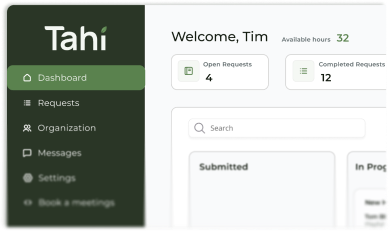Marketing
Your Webflow SEO blueprint for 2025
Unlock your site's potential with our complete Webflow SEO blueprint for 2025. Learn the technical, content, and image strategies to rank higher on Google.

As the head developer at Tahi Studio, I've seen first-hand how Webflow can empower businesses to build incredible online experiences. But there's a common misconception I want to clear up. A beautiful Webflow site doesn't automatically equal SEO success. While the platform gives you an incredible head start, getting to the top of Google in 2025 requires a thoughtful, strategic approach.
Think of Webflow as a high performance vehicle. It has all the potential for speed and precision, but it still needs a skilled driver who knows the route. This article is your map. We'll walk through the technical foundations, content strategies, and measurement practices that turn a great Webflow site into an organic growth engine.
Laying the technical SEO foundation
The good news is that Webflow handles a lot of the tricky technical stuff right out of the box. You don't need a dozen plugins to get the fundamentals right. This clean, efficient base is one of the main reasons we choose to build with it. Think of it as having a solid foundation poured for you. Now, we just need to build the house properly.
Clean URLs and canonical tags
Webflow automatically generates clean, readable URLs for your pages without any strange parameters. This helps search engines and users understand your site structure. It also automatically adds canonical tags to your pages. These tags are crucial for preventing duplicate content issues by telling Google which version of a page is the primary one you want to be indexed.
Automatic sitemaps
Your website's sitemap is essentially a list of all your pages that you want search engines to crawl and index. Webflow creates and maintains this for you at yourdomain.com/sitemap.xml. Your first step after launching a new site should be to submit this sitemap URL to Google Search Console. This simple action helps Google find and understand your content much faster.
Managing your robots.txt file
The robots.txt file gives search engines instructions about which pages or files the crawler can or cannot request from your site. While Webflow's default settings are suitable for most websites, you can easily customise this file in your Project Settings if you need to block specific crawlers or disallow certain pages from being indexed.
Mastering on-page content optimisation
With a solid technical base, your next focus is the content on each page. This is where you can truly signal your relevance and authority to both users and search engines.
The crucial H1 tag
Every page on your site must have one, and only one, H1 tag. This is your main page title and should clearly state the page's purpose. Aim for a length between 20 and 70 characters and make sure it includes your primary target keyword for that page.
Structuring with H2 and H3 tags
Your heading structure is the skeleton of your page. It tells readers and search engines what your content is about and how it's organised. Use H2 tags for main sections and H3 tags for sub-points within those sections. A common mistake we see is skipping heading levels, like jumping from an H1 straight to an H3. It's like skipping a chapter in a book, creating a confusing structure. Tools like the HeadingsMap Chrome extension can help you visualise and validate your page's structure.
Writing compelling title tags and meta descriptions
These elements don't appear on your page itself, but they are what users see in the search results. They are your first chance to earn a click.
- Title Tags: Keep them under 60-70 characters. They should summarise the page content and include your primary keyword, ideally near the beginning.
- Meta Descriptions: These should be between 150-160 characters. Think of this as a short sales pitch for your page. Include secondary keywords and a clear reason for the user to click.
Scaling with the Webflow CMS
This is where the magic of Webflow really shines for larger sites. Instead of manually writing a unique title tag for hundreds of blog posts, you can set up a dynamic template. For example, you can automatically pull the 'Post Name' and 'Category' from your CMS to create a perfectly optimised title like '[Post Name] | [Category] | Your Brand'. It's a huge time saver and ensures consistency, as detailed in Webflow's own SEO resources.
Optimising images for search and users
Image optimisation is no longer optional. With research showing that around 35% of Google search queries now return image results, it's a significant traffic opportunity you can't afford to ignore.
Writing descriptive alt text
Alt text, or alternative text, serves two main purposes. It describes the image for visually impaired users using screen readers, and it provides context to search engines. A great alt text is descriptive and naturally includes relevant keywords. For example, instead of "dog", use "A golden retriever catching a red ball in a park". Webflow's built-in Audit panel is fantastic for quickly finding any images on your site that are missing alt text.
Image performance and core web vitals
Large, uncompressed images are one of the biggest causes of slow websites. Slow sites lead to poor user experience and lower rankings. Before uploading images to Webflow, make sure they are compressed to a reasonable file size. Webflow also helps by automatically enabling lazy loading, which means images only load as they enter the user's viewport. This is crucial for improving your Core Web Vitals, particularly the Largest Contentful Paint (LCP) metric. This directly relates to page speed optimisation, which is essential for both SEO and user experience.
Measuring and refining your strategy
SEO isn't a 'set it and forget it' activity. The digital landscape is always changing, so continuous monitoring and refinement are key to long term success.
Integrating with Google's tools
Connecting your Webflow site to Google Analytics 4 and Google Search Console is non-negotiable. GA4 helps you understand user behaviour, like which pages they visit and how long they stay. Search Console is your direct line of communication with Google, showing you which search queries are bringing people to your site, your click-through rates (CTR), and any technical issues Google has found.
Using data to find opportunities
Don't just collect data, use it. Dive into your Search Console reports and look for queries that have high impressions but a low CTR. This often means your page is ranking for a term, but the title tag and meta description aren't compelling enough to earn the click. Rewriting them could provide a quick win. Similarly, use Google Analytics to identify pages with a high bounce rate. This is a signal that the content isn't meeting user expectations, and it may be time for a refresh.
Final thoughts
Getting your Webflow SEO right isn't a one-time task. It's an ongoing commitment to quality, relevance, and user experience. By building on Webflow's strong technical foundation with meticulous on-page optimisation, a smart image strategy, and continuous monitoring, you create a powerful engine for organic growth.
If building this solid digital foundation feels like a bit much to handle on your own, this is exactly what we partner with businesses to achieve at Tahi Studio. We handle the complexities so you can focus on what you do best.
Ready to unlock your site's organic potential? Explore our SEO-focused approach or start with a free site audit to discover exactly where your current SEO strategy stands and what opportunities await.








